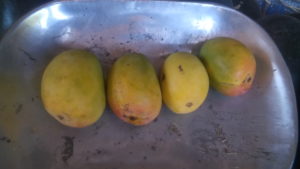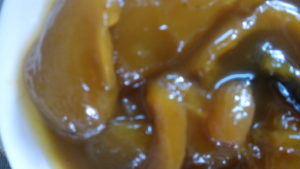Ambakalyo is not a preserve it is a recipe for a Parsi Ripe Mango sauce quick and easy sauce recipe. Ambakalyo is a delightful, light and happy dish to be served in the heat of summer , the height of the Mango season in India. Ambakalyo is delicious; eaten with red/white rice or any bread — whether baked in an oven or cooked on a griddle including tortillas, chapattis, corn bread and pita . The bright orange colour of the finished dish of the Mango Ambakalyo only adds to its appeal. Ambakalyo, by itself, makes for a popular meal in a Parsi household and saves the mother from long hours in the grueling heat of the kitchen.
Ambakalyo also makes a scrumptious sauce for all roast meats and fowl — especially Roast Chicken and Pork; if you are so inclined to use it. The sweet and slightly tart-chili tang of the sauce goes a long way in enhancing the flavours of your dish. Visually too, the translucent orange colour , reminder of scenic sunsets, and the thick consistency of the sauce is tremendously appealing.
Mango is the traditionally accepted fruit to make an Ambakalyo and the name itself “Amba” meaning ‘Mango’ in Gujarati and ‘Kalyo’ meaning ‘Grated, Shredded, made into a Paste’ suggests that the dish is essentially made from Mangoes cooked to the consistency of a thick paste. The ingredients and the Gujarati name suggests that the Parsi-Zoroastrians of India learnt to make the Ambakalyo after migrating to India. However, the word ‘Kalyo’ is no longer found either in Persian or Gujarati; but in Filipino the word “Kalyo” still exists the meaning has declined and is used to denote ‘a Shredder’.
If you are inclined to innovate, like I am, you may add oranges or other citrus fruit, or pineapple or green apple or passion fruit (yellow or purple) any tart fruit of your choice to the recipe at the stage where you introduce the sliced Mangoes into the melted Jaggery/sugar mixture.
Replacing Mangoes, altogether, with another tart and fleshy fruit or a combination of fruits would give you a Orangekalyo, Citrouskalyo, Pineapplekalyo, or green-applekalyo or passion-fruitkalyo or Kalyo of your choice. The entire Recipe will remain the same except that the Mango will be added onto or replaced by another fruit. This would make an equally delicious sauce and a seasonal sauce, at that!

INGREDIENTS:
6 Ripe Mangoes (Alfonso or Pairi preferred; but you may use your favourite);
250 Gms (½ lb) pearl onions (can replace with small red onions or diced regular onions. The taste with each will differ but all taste good);
250 Gms Jaggery as per original recipe; (or Sugar, if you prefer. In which case take 200 Gms of sugar);
3 cloves;
1 inch piece of cinnamon;
Juice of 1 lemon;
1 tsp chili powder;
A pinch of Turmeric powder;
1 clove Garlic;
¾ inch piece of Ginger.
METHOD:
Peel and slice the Mangoes (you may also use the seed),
Slice the Ginger and Garlic,
If using large onions, quarter them,

Fry the onions lightly and place aside,
If using small onions fry them whole,
Now, boil the jaggery/sugar in 2 spoons of water,
Add chili powder, Turmeric Powder, Ginger, Garlic, Cloves and Cinnamon.
Boil till all the jaggery/sugar has melted,
Then, add the mangoes and onions and cook boil for 5 minutes,
Simmer for another 20 minutes or until mango and seed orange and translucent.
Your Ambakalyo is ready to eat.
SERVE: Hot or cold with chapattis, preferably made of rice flour.
]]>Tortillas are not made from simple corn meal or makkai ka atta, as is commonly believed. The special dough for tortillas and tamales is a four- thousand-year-old ‘Masa Harina’ (see below), a name of Nahuatl origin (native southern Mexico and Central America, including the Aztecs). For burritos, quesadillas and tacos, one uses the ‘Flour Tortillas’ (Check ‘Flour Tortillas on this blog).

A quaint Mayan legend relates the ‘ tlaxcalli’, (pre-European, Nahuatl name for Tortilla) with an old peasant who invented the tortilla for his hungry king. The name Tortillas came with the Spanish discovery of the Americas. Tortilla is Spanish for ‘little torta’ or ‘small cake’, a soft, thin flat bread from Mexico which predates the advent of Europeans to the Americas. For Tortillas one uses water based , unleavened dough — the ‘MASA HARINA’ (explained below).,
Tortilla amongst the Nahuatl was a basic dish like the Indian ‘Roti’, treated differently by the various Latin American regions.
Variations of the Tortilla:
Aztecs used squash and amaranth, turkey eggs or honey as a flavoring to their tortillas.
Tortillas called ‘Titiyas’ in Guam, is eaten with a kind of chutney called ‘kelaguen mannok’, made with shrimp, meat ,beef or liver , flavoured with lime or other citrus and spices.
The Guatemalan they are thicker and larger than the usual tortilla.
El Salvador make tortillas from maicillo or sorghum (Indian name ‘Jowar). Like the rural folk’s ‘Bhakri’ in India, the people of El Salvador, cook a particularly large and thick tortilla , ‘Chenga’ often used as an edible plate by farm/plantation labourers.
Like the Indian Paratha, Salvador and Honduras also stuff savoury fillings in Tortilla and this traditional ‘pupusa’ is accompanied by a spicy cabbage slaw. Lastly, not to miss out on the Flour Tortillas in Hoduras used to make ‘baleadas’, a tortilla sandwich filled with cream, eggs, beans and the like.
The corn for Tortillas is treated to a process atleast four thousand year old , known as ‘nixmalization’, before being ground to coarse flour. The method of making tortillas has been practised since 2,000 BCE at least if not earlier. In Guatemala archaeologists have found solid remains of nixmalization dating back to 1500 BCE. Some place the origin of tortillas to 10,000 BCE. Whatever the correct date of origin , it is obviously very ancient.
‘Masa Harina’ (Spanish for “dough flour’) the nixmalised product from which tortillas and tamales are made, is the finely ground corn flour of dry corn cooked in alkaline water (normally slaked with lime) which loosens the pericarp (outer hull). The cooked corn is then repeatedly soaked and rinsed to remove the caustic alkali, then dried once again before grinding. The process of nixmalization raises the nutritional value of the grain as it frees the proteins in the grain
Recipe:
To make: 12 tortillas.
Ingredients:
250 Gms. Masa Harina (available on Amazon in India);

5 pint cold water;
Salt to taste.
Traditionally, no fat is added to the dough for tortillas. In recent times the tendency is to add some oil , butter, lard or other fat while preparing the dough. You may choose to add your choice of fat or make tortillas the traditional way.
Method:
- Sift the Masa Harina and salt into a mixing bowl.
- Gradually pour in most of the water, stirring constantly.
- Knead the mixture with your hands, adding more water, a little at a time, until the dough is firm (atleast 5 minutes) and no longer sticks to your fingers and is really smooth.
- After kneading if you rest the dough for 15 minutes, the gluten develops and dough becomes pliable making the process of rolling tortillas easier.
- If in a hurry, you may skip step (4) above.
- Divide the dough into 3 or 4 batches
- With a rolling pin, roll each batch between long strips of waxed paper until the dough is about 1/16 of an inch thick.
- With a plate or a saucepan lid as a pattern, cut the dough into 5-inch rounds.
- Stack the rounds between pieces of greaseproof paper.
- Dry roast on pan or skillet or griddle.
- Heat the griddle. If you do not heat the griddle, the tortilla will dry out become stiff and hard while cooking. A hot griddle will ensure the tortillas cook to a nice soft texture.
- Place the tortilla , one at a time on the griddle.
- Cook for about a minute or two till the outer edges of the tortilla begin to appear dry.
- Flip the tortilla and cook on the other side for about a minute till lightly browned.
- Flip again onto the original side and let the tortilla rise.
- Remove from fire, place the next tortilla and treat similarly till all twelve are done.
Tortillas may be eaten with Ranch Eggs (recipe on the blog); with guacamole or simply with sea salt and chili powder. I love the last.
]]>